'We are trapped in the house that killed our son'
- Published
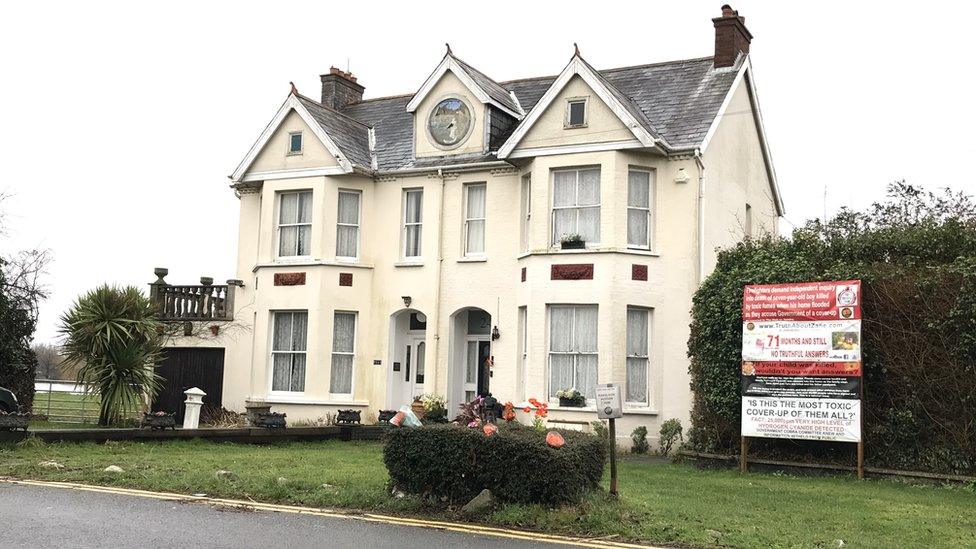
A prominent campaign board now stands outside the house where Zane Gbangbola was poisoned
When Kye Gbangbola and Nicole Lawler moved into their house on the banks of the River Thames in Surrey, it looked like the perfect place to raise a family. Sixteen years later, it stands as a reminder of Zane, the son they lost, while their fight for answers continues over what caused his death.
On 7 February 2014, Mr Gbangbola spent the evening working upstairs in his study, where he was writing to the Environment Agency requesting an urgent meeting about the effects of several weeks of flooding, which had left the basement of the house underwater.
Ms Lawler and Zane watched the Winter Olympics opening ceremony and later she carried her seven-year-old son to bed. But not long afterwards, Ms Lawler, who was acutely ill herself, found him unconscious, while his father - who would be left paralysed - was critically ill in another room.
Zane was taken to hospital but later pronounced dead.
Ms Lawler has described how her son died in her arms and how she held him "until his little fingers froze around mine".
The couple believe the inquest into their son's death, which concluded in September 2016, was flawed. Zane's death was attributed by the coroner to carbon monoxide poisoning from a petrol-powered pump used by the couple to clear floodwater - but which they insist was not in use.
They believe a former landfill site behind their home in Chertsey was the source of hydrogen cyanide gas, which was forced up and out of the earth by the "piston effect" of the swollen river raising the level of the water table underground, and it was this gas that killed Zane.
Firefighters found high levels of hydrogen cyanide at the property, according to the Fire Brigades Union (FBU), which has "serious concerns" about how the inquest was conducted.
Still unable to sell the house, the couple remain there, constantly reminded of the absence of their son.
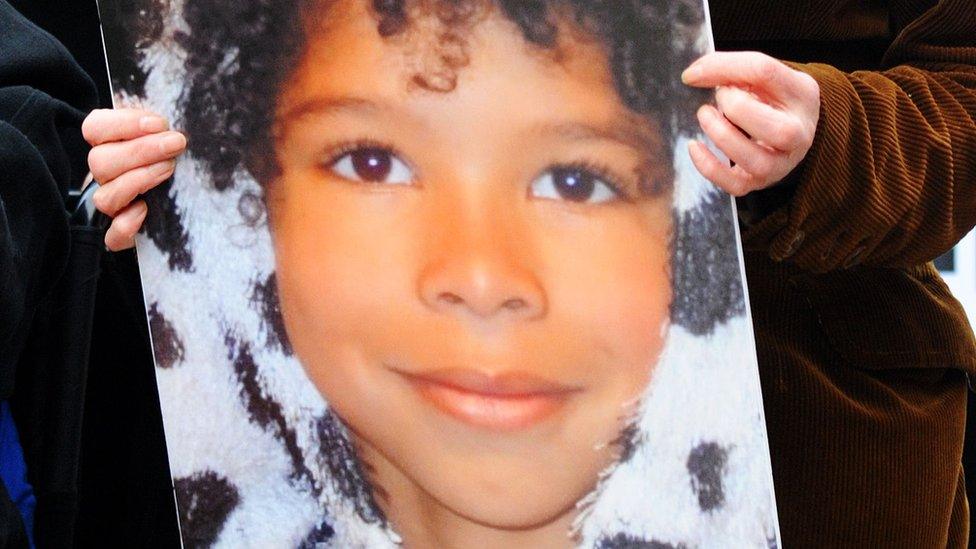
A petition calling for an independent panel inquiry has reached more than 108,000 signatures
They had moved into the four-bedroom home 10 years earlier. Surrounded by floodplain meadows, the house looked out on to boats sailing on the river and the 18th Century stone arches of Chertsey Bridge. It also backed on to a field with a lake and grazing horses.
They were close to London and the countryside of well-to-do Surrey. The location seemed idyllic.
When the couple bought the property, they knew it was in a flood-risk area, but Mr Gbangbola, a European buildings expert, believed it was a risk that could be managed and insured against.
Zane was born on 21 October 2006. When he was older, Ms Lawler - an environmental expert who worked on the London 2012 sustainability strategy - was able to drop her son at school, fly from nearby Heathrow to the Netherlands to attend a business meeting, and be back for home time, dinner and bed.
Zane would race along the riverside path and explore Chertsey Meads, where he discovered a BMX track and became an ace on his bike. Around the corner was Dumsey Meadow, home to his "wishing tree", where his mother hid treasures for him to find.
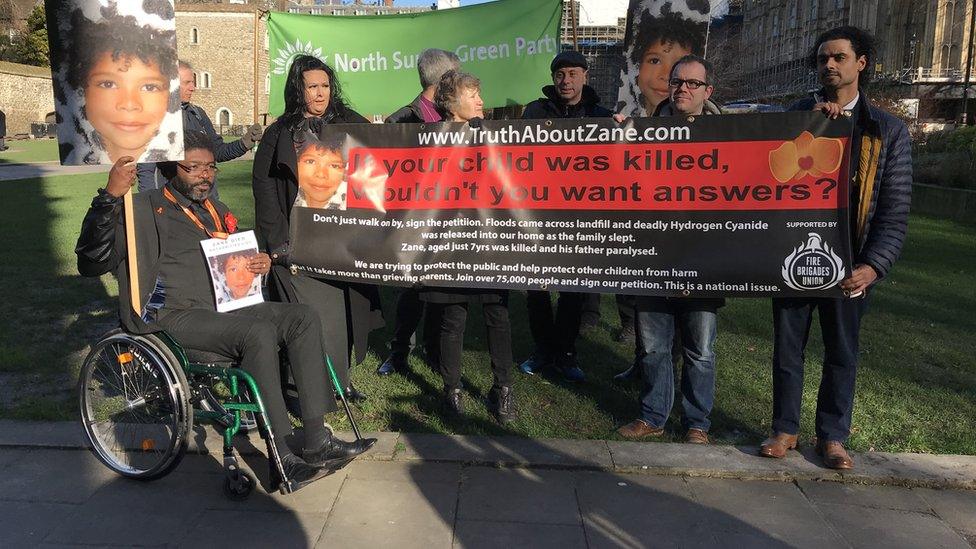
Zane's parents (left) and campaigners gathered at Westminster earlier this month
When Mr Gbangbola and Ms Lawler bought the house, they said no environmental searches identified that the field behind it was a former landfill site, and that this information only came to light after their son had died.
They have spent the past six years gathering information they say was not explored or disclosed at the inquest, and which they want to be put before an independent panel inquiry.
This includes the existence of a Defence Evaluation and Research Agency (DERA) military tank-testing facility, identified as a former industrial site in Runnymede council's land contamination strategy, external.
A former Ministry of Defence (MoD) engineer, who asked to remain anonymous, has told the BBC he believes subcontractors working for the tank-research facility five miles from the house used to dump waste chemicals in local gravel pits, including behind Zane's house.
He said those chemicals were by-products from anti-rust and anti-corrosion tank coatings and he claimed they could produce cyanide. They would have been put into drums that rusted and corroded over the years, allowing chemicals to leach into the ground, he alleged.
The BBC has agreed to protect his identity as a former MoD worker, but has therefore been unable to verify the claims.
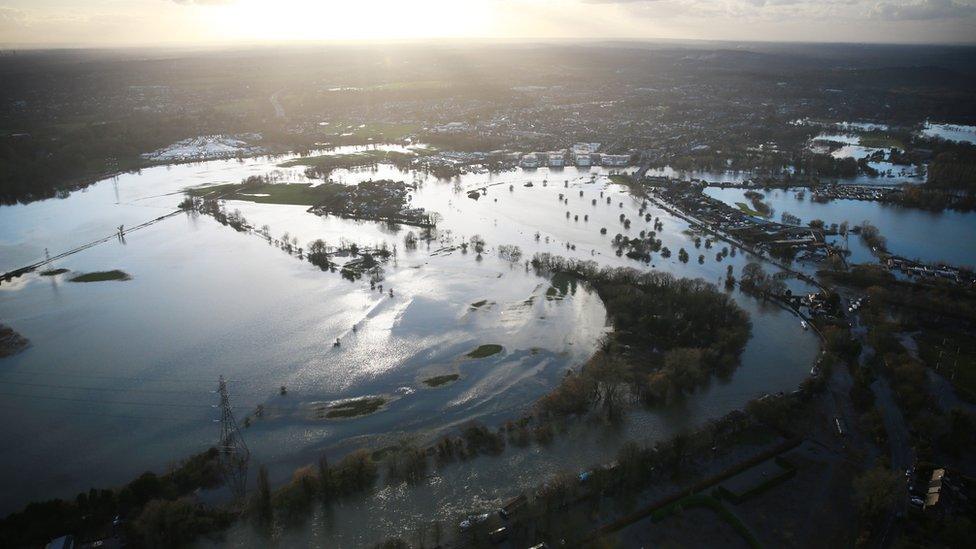
February 2014 saw 14 severe flood warnings on the Thames before the river burst its banks
It recently emerged during a commemoration for Zane, held at the House of Lords, that experts from the government's defence laboratory, Porton Down, were involved in the response to his death.
At that event, Manchester's Labour mayor Andy Burnham said: "I want the truth about Zane. I don't think we do have the truth about what happened to this lovely little boy.
"There were many authorities involved," the former health secretary said. "Porton Down was also involved. Did any of this come out in the inquest? No it didn't. Therefore, the full story clearly wasn't told at the inquest and it needs to be."
In his report at the conclusion of the inquest, the coroner Richard Travers cited an expert who said high levels of hydrogen cyanide were rare and all associated with former gasworks, while a council officer said there had been no significant pollution incidents on the land behind Zane's home since the 1950s.
However, another report referred to by the coroner did acknowledge that illegal tipping could have taken place, and a further expert, geo-environmentalist Gavin Roberts, told the inquest it was possible floodwater had triggered a one-off discharge of hydrogen cyanide and carried it to the basement of the house.
The coroner's report, external did not look at the area's military and defence history.
In December, the FBU's general secretary Matt Wrack wrote to the family: "Our members attended that fateful day in 2014 and found hydrogen cyanide in your home."
He said there were "disturbing gaps in the evidence", adding: "The unregulated landfill site adjacent to your home seems to have released the nerve gas and there must now be an independent inquiry so this can be looked at, and those found responsible must be held to account."
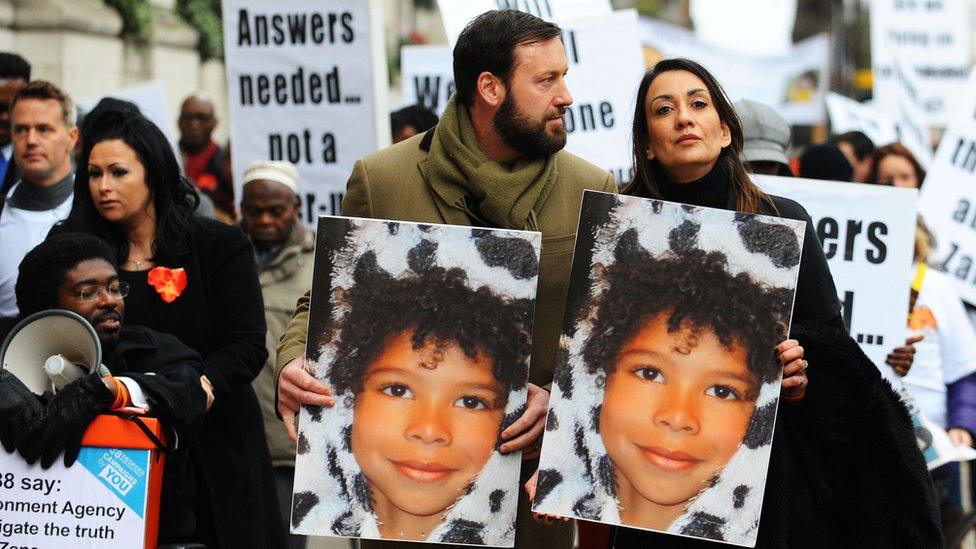
Protesters have spent years campaigning for an inquiry into Zane's death
Ann Boater grew up in the house by the Thames, which was sold by her mother Jocelyn to Mr Gbangbola and Ms Lawler in 2004.
She remembers a childhood that included rambling across fields and wading through floods in gumboots when the water levels rose.
The garden and the cellar of the house would flood from time to time, she remembers, but it only ever took the labels off the wine bottles stored there and it never reached her mother Jocelyn's prized parquet floor.
"It was never anything other than exciting," she said. "It was a worry for my mother but there was a lot that was very beautiful about living there."
She has described how what was a gravel pit in the field behind the property was later used as a waste dump and was for a time unregulated, before it deteriorated into an eyesore. For a time "anyone could throw anything in it", she said.

Ann Boater remembers the house being "quite a bit higher" than the river near Chertsey Bridge
"There were rusty old mattresses and we bounced on them," she said. "But then there was a period when it was such an eyesore, we didn't want to go there at all."
Eventually the rubbish tip was filled in and forgotten about, she recalls.
Now a member of the Green Party who has stood as a council election candidate in Islington, Ms Boater has called for the land to be tested properly. "If something's happened, we need to know it's not going to happen again," she said.

Zane's parents have gathered a range of evidence they say was not explored at the inquest
Six years on from the floods, the house by the river now stands as a reminder of what happened to the boy who lived there. There is a campaign board at the front of the property, while in the back garden there is still a child's playhouse and a football.
Zane's parents had to stay out of their home for a year after his death, while investigations took place there. Mr Gbangbola said that after the devastation the family had suffered, it was in a sense shocking to find the house unchanged.
"The house was completely normal," he said. "The only thing removed was Zane, so the desire to live there had gone."
By the time she and her partner returned to the house, Zane's smell had gone from his room and his clothes, Ms Lawler said.
Describing their lives on the Chertsey riverbank now, she simply said: "It's no longer a home."

Mr Gbangbola spoke to BBC Surrey in January 2014 as the people of Chertsey battled floods that winter
The couple have said they would leave the property if they could, but have found they are unable to sell it.
After the death of Zane, they received a letter from a lawyer offering them £10,000 from a prospective buyer for the house - a move that Mr Gbangbola described as opportunistic and cynical.
In 2017, the couple applied for permission to build a gas-proofed and flood-protected house in their garden so Mr Gbangbola could have a wheelchair-accessible home - he said so much work was needed to adapt the existing house to his needs that this approach made financial sense.
However, consent was refused for what was described as inappropriate development in the greenbelt.
Meanwhile, no estate agent is prepared to value the house while their dispute continues and questions remain over the landfill site, Mr Gbangbola said.
"The place is empty for us as a family. What can you do when you can't sell it? You have to suffer that trauma, day in, day out.
"There's no heart, or voice, or laughter, no banging around. It's no longer the same."

The BBC has taken all claims about historical contamination in the area to the Ministry of Defence (MoD), the Environment Agency and Defra, and also to the two local authorities, Runnymede and Spelthorne councils. The tank facility was run by the former Defence Evaluation and Research Agency, which was part of the MoD and was later split into the Defence Science and Technology Laboratory, external (DSTL) and Qinetiq, external. The BBC approached DSTL, which has its headquarters at Porton Down, for comment but was referred to the MoD.
The MoD declined to comment unless formal allegations were made.
Defra, commenting for the government and the Environment Agency, said: "This is a tragic case and our thoughts remain with the Gbangbola family. There has been an inquest into the cause of Zane's death. The inquest heard from many witnesses, and throughout the Environment Agency provided detailed evidence to assist the independent coroner in reaching his conclusion."
Runnymede council said to the best of its knowledge it had no information regarding potential contamination from the former DERA operation. It said the site was identified as an area of potential contamination due to its former use but the ongoing redevelopment of the land had been through the planning process and conditions were put in place requiring contaminated land investigations and remediation.
Spelthorne council said the coroner's report set out details of tests on the land carried out by the landowner, the Environment Agency and the family's insurers and quoted the coroner's statement that "on the balance of probabilities...there was no hydrogen cyanide present in the house". It said the lake behind the house was analysed quarterly by the landowners and was a healthy environment, adding that the landowner had analysed an on-site borehole for ground gas on a regular basis for a number of years.
Asked if there was any evidence of illegal dumping by DERA subcontractors, Spelthorne council said "no".
Claims about contamination in the area have also gone to Surrey County Council, which has not yet responded.
On the sale of the house to Mr Gbangbola and Ms Lawler, Spelthorne council said: "The family did not approach the council's land charges team to request a full land search when they were buying the house and did not ask any environmental questions of the council at purchase. The landfill is referred to in search responses made by the council to other environmental conveyancing inquiries for Chertsey Bridge Road properties made between 1998 and 2008. Environmental searches with a commercial company have been recommended by the Law Society as per instructions issued in 2001. The presence of historic landfill would have shown up on this if one had been purchased in 2004."
Regarding claims by the family that landfill was regulated but regulations were breached, Spelthorne council said: "Filling around the south lake appears to have taken place in 1968. Consented materials were those excavated from the land in its natural state including excavation from building sites; builders rubbish; brick and hardcore; clinker and ashes. There are no records of contraventions of the tipping consent in this area."
The BBC has approached landowner Brett Aggregates for comment.
Coroner Richard Travers, as an independent member of the judiciary, has not commented on the case.
Related topics
- Published12 February 2020

- Published11 October 2019

- Published8 February 2019
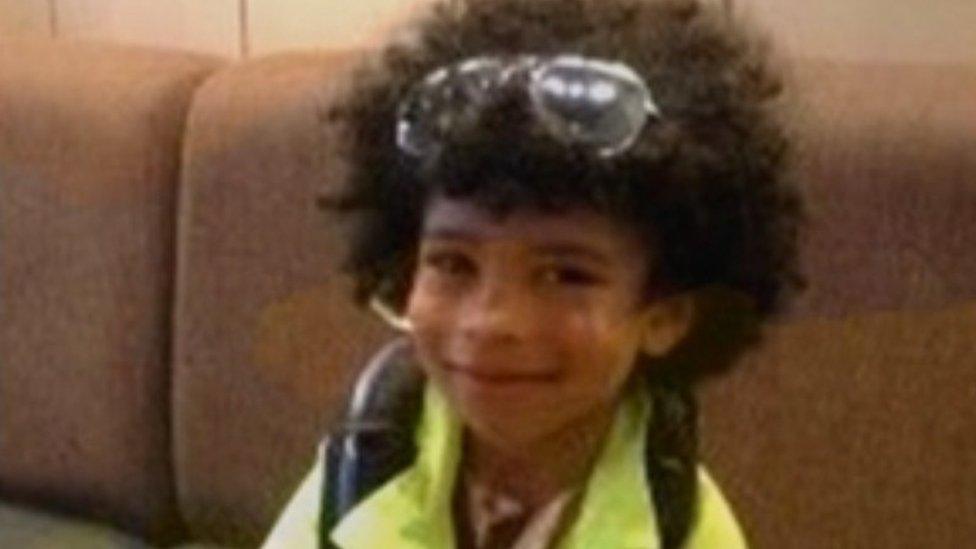
- Published7 September 2016
